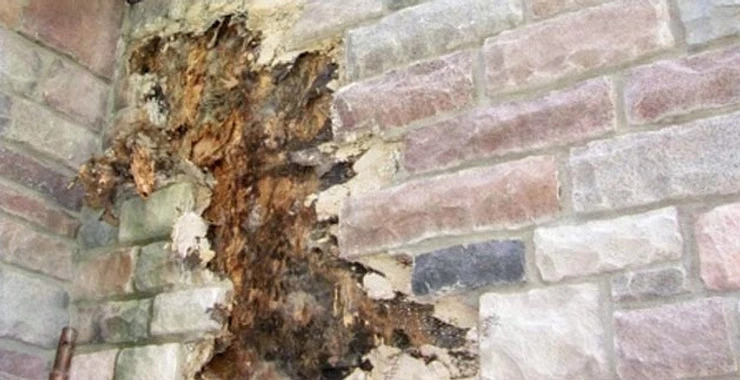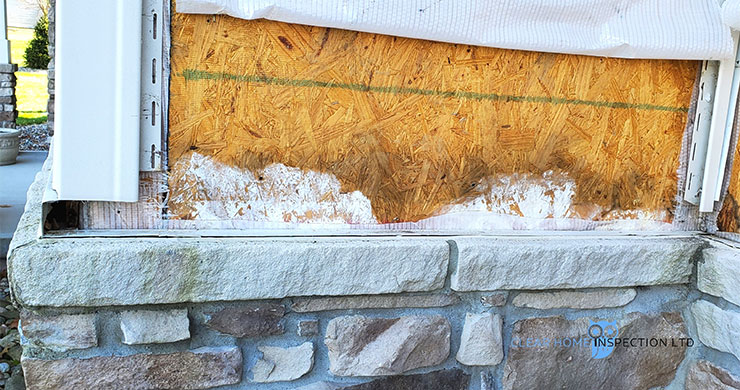Your Homes Beautiful Stone Front May Hold A Nasty Secret.

So where’s the issue?
Unfortunately many (AMSV) Adhered Masonry Stone Veneer facades have not been correctly installed and allow water in behind where it will rot the wood framing. Often these issues go unnoticed until stones start falling off and revealing the concealed damage.

It’s All In The Details
Careful attention must be paid during installation to prevent moisture intrusion. When this new stone siding became available many installation crews did not received the proper guidance or training. A proper installation requires extra steps, material and has many installation limitations. It seems these hurdles were just too inconvenient to be discussed by those in the know, like architects, designers and GCs. After all time is money and everybody else was installing it without issue, yet.
Better Late Than Never
Now we have resources like the Masonry Veneer Manufacturers Association (MVMA) Installation Guidelines. (Also known as NCMA) But it has come a bit too late, the expectation for installation cost had already been set in the mind of consumers, builders & designers alike. Following MVMA Guidelines takes more time and costs more money. Any contractor following them and trying to compete has an uphill battle.
Below are some images from the MVMA guidelines showing some of the more common issues I find during home inspections
 .
.  .
. 
A Peek At The Scale Of The Problem Installs
Working as a GC I ordered some of this stone from a local Northeast Ohio Supplier. When I requested the required Weep Screed(a critical key to correct installation) the rep replied that he has been selling this type of stone for 10 years now and they have never heard of or sold a single inch of weep screed!! That was in about 2012, it’s now 2020 & as a home inspector I still sometimes see this stone incorrectly installed during new construction and remodeling.
Hold On, The Worst Is Yet To Come
Now installation problems with this stone are no secret and the scope of the existing bad installs within our housing stock is starting to reveal itself. This was highlighted in an article in the Journal of Light Construction(JLC) magazine. Formerly The New England Journal of Light Construction. The author explains how this problem has the potential to dwarf the EIFS & Stucco problems experienced in the 80s & 90s.

Some Good News
Not all Stick On Stone Veneers have been installed incorrectly, Many have been installed correctly by reputable contractors in the know. And after news of water damaged homes & subsequent lawsuits, the word is getting out. More and more contractors are following MVMA guidelines during installation.
How Do I Know If My Stone Is Installed Right?
Here’s Some Obvious Issues To Look For:
-
The flashing between the stone and siding above (often incorrectly pitched or missing altogether). While the difference between correct and incorrect may be subtle it is crucial to keep out water
See how this incorrectly installed flashing has allowed water damage to start on this nearly new home. Water could not drain of the top off this flashing and so drained in through the seams.

-
Missing weep screed, dimple mat or lack of adequate ground clearance. While less of an issue than the flashing, will still allow for water damage at the wood framing behind.
Some Issues are not so obvious.
Like Kick out flashings at the roof/wall intersections or through wall flashings above windows & doors or the weather resistant barrier layers & drainage mats behind the stone. Unfortunately some issues just cannot be seen without some dismantling.
Below you can see the wet stone below the area that should have a kick out flashing. The caulk on the shingles is also a red flag of an incorrect install.

So How Do I Protect Myself From What I Cannot See?
Hire a good Home Inspector who is certified in Infrared and has real construction industry experience. An infrared camera can show us what would otherwise be invisible and real construction industry experience enables us to understand what we are looking at.
Take a look at this image below from a past inspection, you can clearly see the dark areas where water was getting in behind the stone.

Conclusion
Faux Stone Veneer itself is not bad, however many have been installed with defects that can cause real damage to your home. Protect yourself by only hiring reputable contractors who adhere to MVMA Guidelines. If your not sure about your stone, or are buying a home with this stone on it, hire a State Licensed Home Inspector or Reputable Masonry Contractor to evaluate it.
Do You Have Stone Veneer on Your Home that you suspect may be installed incorrectly?
Let me know in the comments below and I’ll be happy to provide any insight I can. You can even leave a photo for me to look at.

Arthur Duhaime is a Ohio Licensed Home Inspector and Ohio Department of Commerce Certified Instructor for Real Estate Continuing Education. Arthur’s industry leading home inspections glean insight from 2 decades of real construction industry experience.





Leave a Reply
Want to join the discussion?Feel free to contribute!